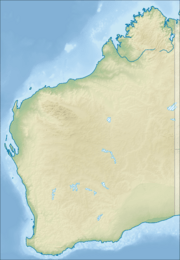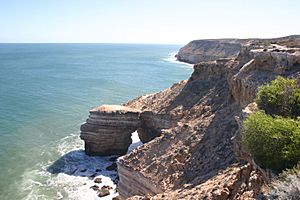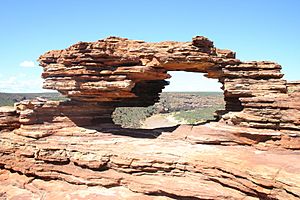Kalbarri National Park facts for kids
Quick facts for kids Kalbarri National ParkWestern Australia |
|
|---|---|
|
IUCN Category II (National Park)
|
|
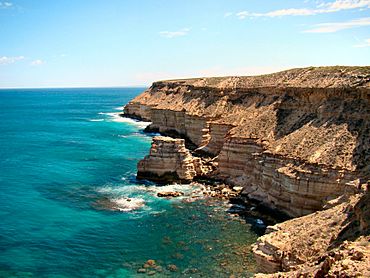
From the coastal section of the park, cliffs running south from the town of Kalbarri.
|
|
| Nearest town or city | Kalbarri |
| Established | 1963 |
| Area | 1,830.05 km2 (706.6 sq mi) |
| Managing authorities | Department of Parks and Wildlife (DPaW) |
| Website | Kalbarri National Park |
| See also | List of protected areas of Western Australia |
Kalbarri National Park is a special place located about 485 kilometers (301 miles) north of Perth. It's in the Mid West region of Western Australia.
This park is famous for its amazing natural features. You can find a deep gorge carved by the Murchison River, which stretches for almost 80 kilometers (50 miles). There are also stunning cliffs along the coast near the town of Kalbarri.
Contents
Exploring Kalbarri's Geography
Kalbarri National Park protects a unique part of Australia. It includes inland desert areas with red and white striped rocks called Tumblagooda sandstone. This is especially true along the lower parts of the Murchison River and its deep gorge. The park also covers the area where the river meets the ocean, near Meanarra Hill.
The western side of the park protects the coastline south of Kalbarri town. Here, you'll see cliffs that are over 100 meters (328 feet) high! The wind and water have shaped these cliffs into cool rock formations. These include a sea stack (a tall rock column in the sea) and a natural bridge (a rock arch).
Weather and Climate in Kalbarri
Kalbarri National Park is open all year. However, it can get extremely hot from December to April. The park is located where two climate types meet: a Mediterranean climate and a semi-arid climate.
Winters are warm with some rain. Summers are hot and dry. Temperatures often go above 40°C (104°F) in the inland parts of the park. Inland areas can be more than 10°C (18°F) hotter than the coast. Most rain falls from May to August. Heavy rain can sometimes cause the roads to the gorge to close.
Amazing Plants of Kalbarri
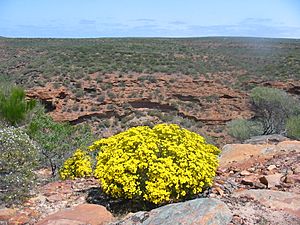
The Kalbarri area is well-known for its many different wildflowers. More than 800 types of wildflowers bloom from late winter to early summer. The best time to see them is usually in August and September.
Twenty-one plant species are found only on the coastal cliffs and in the gorge. One famous local plant is the Kalbarri catspaw. This small yellow or red plant often appears after a bushfire. Several types of orchids are also unique to the park, like the Kalbarri spider orchid and the Murchison hammer orchid.
A plant called the small-petalled Beyeria was once thought to be extinct. But it was found again in the park in 1994! The park has one of only three known groups of this plant.
Animals of Kalbarri National Park
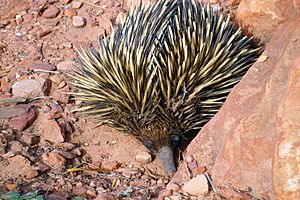
About 200 different animal species have been seen in the park's inland areas along the Murchison River. Near the coast and Kalbarri town, over 400 species have been recorded. The tammar wallaby, which is a threatened animal, used to live here but hasn't been seen recently.
Around 150 bird species have been observed. These include the emu (a large flightless bird), osprey (a fish-eating bird of prey), wedge-tailed eagle (Australia's largest bird of prey), and Australian pelican (a large water bird).
Some mammals found inland are the western grey kangaroo, short-beaked echidna (a spiny mammal), and spinifex hopping mouse. The only bat seen in the park is the Finlayson's cave bat.
Reptiles include the thorny devil (a lizard with spiky skin), western bearded dragon, and central netted dragon. The only amphibian observed is Günther's toadlet (a small frog). About 30 different arthropods (like insects and spiders) have been recorded. These include a dragonfly called the Pilbara tiger and the savanna black tree ant.
Fun Things to Do in Kalbarri
There are many popular activities in Kalbarri National Park. These include sightseeing, boating, fishing, picnicking, and bushwalking (hiking). You can also try abseiling (climbing down ropes) in the gorge. Horseback riding is another option.
If you love the ocean, you can go scuba diving, snorkeling, surfing, and swimming at Red Bluff Beach and Pot Alley. From Kalbarri town, you can take scenic boat trips along the Murchison River or even flights over the park for amazing views. New viewing platforms are being built over the Murchison River Gorge for even better sights.
Park Facilities
It's important to know that there are no campsites or places to stay overnight inside the park itself. Also, there is no water available within the park boundaries. If you plan to stay overnight, you'll need to find accommodation in Kalbarri town. The only exception is if you are on a multi-day bushwalk or boat tour that includes overnight stops.
Must-See Features of Kalbarri
Here are some of the main attractions you can visit in Kalbarri National Park:
Coastal part, starting from the town of Kalbarri and moving south:
- Red Bluff
- Mushroom Rock
- Rainbow Valley
- Pot Alley
- Eagle Gorge
- Shellhouse and Grandstand
- Island Rock
- Natural Bridge
Inland part, along the Murchison River Gorge:
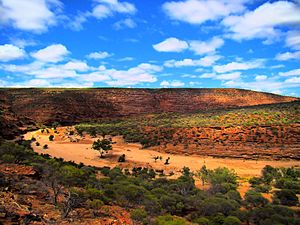
- Nature's Window
- The Loop
- Z Bend
- Hawks Head
- Ross Graham Lookout
Gallery
Images for kids
See also
 In Spanish: Parque nacional Kalbarri para niños
In Spanish: Parque nacional Kalbarri para niños


